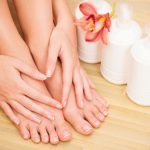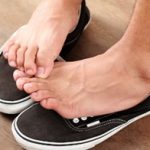 Supportive running shoes are common, but now we are learning that walking barefoot can prevent uncomfortable problems like plantar fasciitis, shin splints, bursitis and tendinitis.
Supportive running shoes are common, but now we are learning that walking barefoot can prevent uncomfortable problems like plantar fasciitis, shin splints, bursitis and tendinitis.
For years people have been singing the virtues of good foot support, such as stress relief on your feet and shock absorption; however, a U.S. foot expert, who spent years studying the human foot core, tells us that going barefoot can improve balance and posture, as well as improve common injuries. Patrick McKeon, Ph.D., who is a professor in Ithaca College’s School of Health Sciences and Human Performance suggests that shin splints, plantar fasciitis, bursitis, and tendonitis are preventable when shoes are tossed aside on a regular basis.
Advertisement
Dr. McKeon explained that there is something called the “foot core feedback loop,” a cycle between the larger muscles of the foot and leg, the smaller muscles of the foot, and the neural connections that pass information from those muscles to the brain. When the feedback loop breaks, injuries occur. He believes the biggest cause of breakdown is shoes.
Dr. McKeon said: “When you put a big sole underneath, you put a big dampening effect on that information. There’s a missing link that connects the body with the environment.”
Walking barefoot: How drawing electrons from the earth improves health
 Environmental medicine looks at environmental factors that impact human health. Science has established that Earth’s surface has a limitless and constantly renewable supply of moving electrons. There is also evidence that Earth’s electrons can be replenished to create a stable bioelectrical environment to accommodate the functioning of all body systems. We know through countless scientific studies that electrons from antioxidant molecules can neutralize free radicals. It is therefore easy to assume that free electrons absorbed into the body through direct contact with the Earth are likely to neutralize free radicals and thus reduce inflammation.
Environmental medicine looks at environmental factors that impact human health. Science has established that Earth’s surface has a limitless and constantly renewable supply of moving electrons. There is also evidence that Earth’s electrons can be replenished to create a stable bioelectrical environment to accommodate the functioning of all body systems. We know through countless scientific studies that electrons from antioxidant molecules can neutralize free radicals. It is therefore easy to assume that free electrons absorbed into the body through direct contact with the Earth are likely to neutralize free radicals and thus reduce inflammation.
Hundreds of years ago, humans walked barefoot or with minimal footwear. For example, footwear made of animal skins. They even slept directly on the ground or on animal skins. Through direct contact with the Earth, electrons entered the body, enabling the body to equilibrate with the electricity of the Earth. This stabilized the electrical environment of organs, tissues and cells. Today, we tend to wear insulated rubber, plastic soled shoes, and of course we don’t sleep on the ground. We also have an increase in chronic illness and inflammatory diseases. Some researchers believe this disconnect with the Earth’s surface is the cause of these ailments. It’s a theory that plays right into the concept that bare feet are better.
Health benefits of going barefoot
While science can explain how direct contact with the Earth’s limitless electrons helps drain free-radicals from our feet, what people really want to know is, What walking barefoot benefits can I reap?
Here’s a list of benefits that might make you want to bare your soles:
 Better balance – you can feel the ground with your toes. For seniors this can be very important.
Better balance – you can feel the ground with your toes. For seniors this can be very important.- Foot strength – toes get stronger and are at less risk of deforming.
- Feeling grounded – you gain a sense of security.
- Healthier feet – toes and the rest of the foot appear healthier.
- Fewer foot conditions – plantar fasciitis dissipates and bunions disappear.
- Greater circulation – gets the blood flowing.
- Better posture – shoes can cause pelvic tilt.
- Less inflammation – studies show reduced inflammatory levels in those who go barefoot.
Is walking barefoot harmful?
There are still some doctors that believe we have to be careful about not wearing shoes. They are concerned about the lack of support and any damage that may occur as a result of walking around barefoot. The biggest concern though, is the possibility of picking up bacteria, fungal infections and viruses. For example, plantar warts are a viral infection. They can be found in locker rooms or around indoor pool decks (wet surfaces).
The other possibility is stepping on a piece of glass or a rusty nail that can lead to an infection. Although it is not as common, hookworm can also be a concern. Hookworm is a parasite found in animal feces. It can enter the skin when it comes in contact with feet. Kids can get hookworm from sandboxes, for instance.
There are other issues with walking around barefoot. There is the fact that in many states driving without shoes is prohibited; there is of course the look of dirty feet and the smell, as well as the risk of changing the appearance of your feet. You can develop unattractive calluses and marks on your feet.
Precautions for walking barefoot
 If you are thinking of making the switch to a barefoot lifestyle, there is a right and wrong way to go about it. The best barefoot walking technique involves a gradual elimination of shoes. If you are a regular shoe walker, try taking a walk in your neighborhood and, at some point, take your shoes off and do part of your walk in bare feet. Or to remove many of the dangers, simply walk around your home without shoes. Doing too much all at once can cause pain or injury. Some experts even say those who are not used to walking barefoot should exercise ahead of time by simply wiggling their toes.
If you are thinking of making the switch to a barefoot lifestyle, there is a right and wrong way to go about it. The best barefoot walking technique involves a gradual elimination of shoes. If you are a regular shoe walker, try taking a walk in your neighborhood and, at some point, take your shoes off and do part of your walk in bare feet. Or to remove many of the dangers, simply walk around your home without shoes. Doing too much all at once can cause pain or injury. Some experts even say those who are not used to walking barefoot should exercise ahead of time by simply wiggling their toes.
Advertisement
It’s important when you are establishing a barefoot walking technique to be conscious of the way your feet feel. Walk around and discover where you feel the weight land in your foot. If it goes to the heel first and then the big toe, shift your weight so it goes from your heel to your little toe. It turns out that the bones in the outer part of the foot are better equipped to support the weight of our body, so landing on a heel and going directly to the big toe can collapse the arch inward. This little adjustment may seem silly, but it can help support the knee, pelvic and abdominal muscles. As you continue to walk barefoot, the muscles in the foot core will get stronger.
Remember to never walk in your bare feet if you have an open sore. Also, avoid walking on soil or grass that has bird droppings or other litter on it. Some scientists say walking on the beach is great because it absorbs energy, as opposed to toxins.
It can be fun to explore walking barefoot, as long as you do it safely. In the beginning, it is smart to stay inside or look for natural grounds, such as dirt paths, grass or sand so that your foot core and skin can get used to contact with the elements. Eventually you will be able to expand your exposure to surfaces. Over time you will experience a noticeable difference in the muscles and joints in your feet and ankles. It’s an added bonus knowing that walking barefoot also has the potential to ward off unpleasant conditions, such as plantar fasciitis, shin splints, bursitis and tendinitis.
